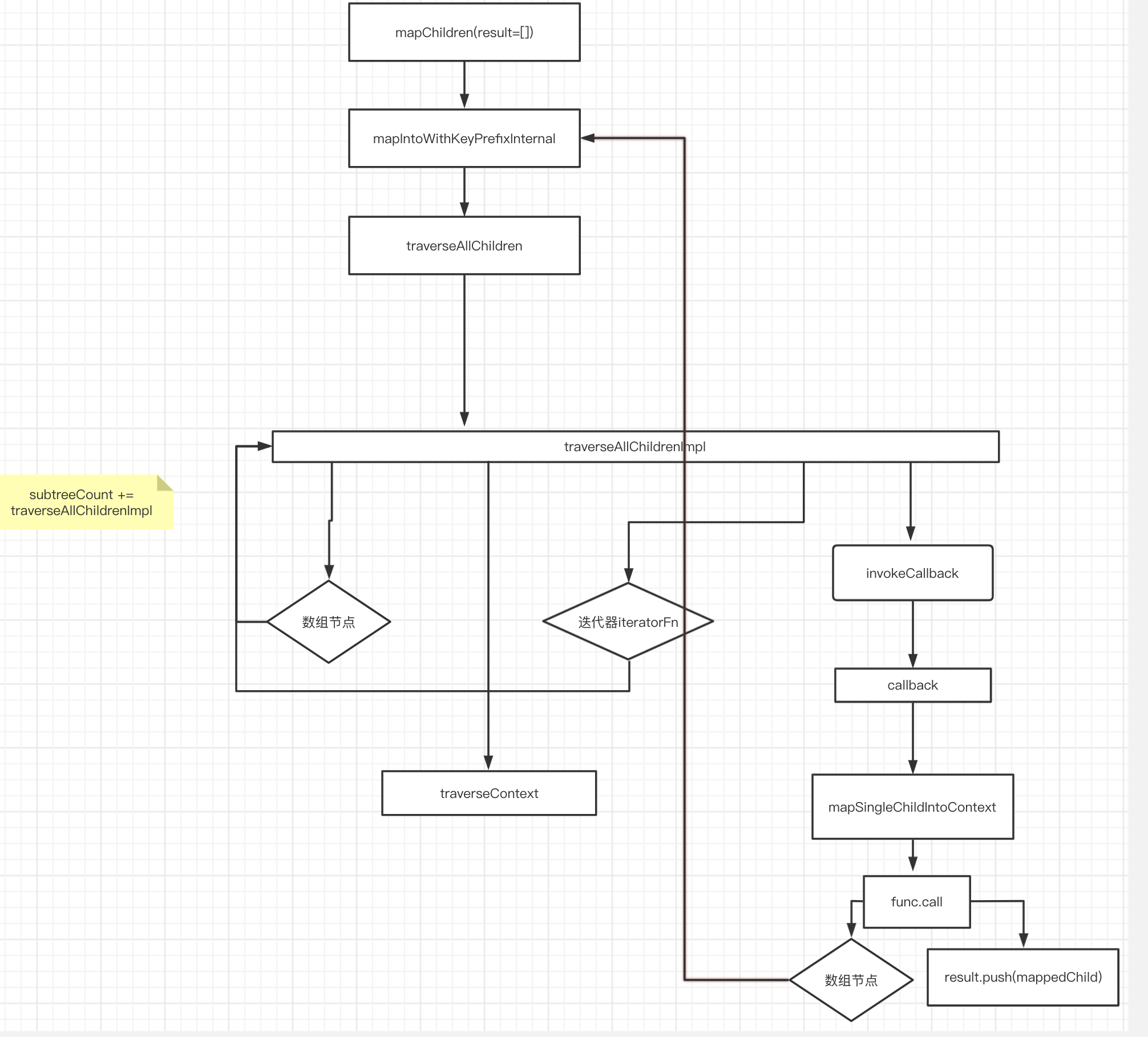# ReactChildren
ReactChildren 对外暴露了以下 几个方法
export {
forEachChildren as forEach,
mapChildren as map,
countChildren as count,
onlyChild as only,
toArray,
};
我们就拿 mapChildren 简单做下分析看看,首先方法如下:
# mapChildren
function mapChildren(children, func, context) {
if (children == null) {
return children;
}
const result = [];
mapIntoWithKeyPrefixInternal(children, result, null, func, context);
return result;
}
接下来 来看 mapIntoWithKeyPrefixInternal
function mapIntoWithKeyPrefixInternal(children, array, prefix, func, context) {
let escapedPrefix = '';
if (prefix != null) {
escapedPrefix = escapeUserProvidedKey(prefix) + '/';
}
const traverseContext = getPooledTraverseContext(
array,
escapedPrefix,
func,
context,
);
// 将嵌套的数组展平
traverseAllChildren(children, mapSingleChildIntoContext, traverseContext);
releaseTraverseContext(traverseContext);
}
getPooledTraverseContext
const POOL_SIZE = 10;
const traverseContextPool = [];
// 维护一个对象最大为10的池子,从这个池子取到对象去赋值,用完了清空, 防止内存抖动
// 可以循环使用,创建太多的话,也会占据内存
function getPooledTraverseContext(
mapResult,
keyPrefix,
mapFunction,
mapContext,
) {
if (traverseContextPool.length) {
const traverseContext = traverseContextPool.pop();
traverseContext.result = mapResult;
traverseContext.keyPrefix = keyPrefix;
traverseContext.func = mapFunction;
traverseContext.context = mapContext;
traverseContext.count = 0;
return traverseContext;
} else {
return {
result: mapResult,
keyPrefix: keyPrefix,
func: mapFunction,
context: mapContext,
count: 0,
};
}
}
getPooledTraverseContext 就是从 pool 里面找一个对象,releaseTraverseContext 会把当前的context对象清空然后放回到pool中。
releaseTraverseContext
function releaseTraverseContext(traverseContext) {
if (traverseContextPool.length < POOL_SIZE) {
traverseContextPool.push(traverseContext);
}
}
releaseTraverseContext 的作用就是会把当前的 context 对象清空然后放回到pool中。
从这两个方法来看感觉 traverseContextPool 永远都是只有一个值,因为每次都是先 pop 完再 push 进去,那么为什么还要 定义POOL_SIZE 为 10呢
那让我们来看看 traverseAllChildren
function traverseAllChildren(children, callback, traverseContext) {
if (children == null) {
return 0;
}
return traverseAllChildrenImpl(children, '', callback, traverseContext);
}
traverseAllChildren 就做了一次简单判断,然后就去调用自己的实现方法(不知道代码是不是后台老哥写的😭),traverseAllChildrenImpl 就流程就比较长一点了
function traverseAllChildrenImpl(
children,
nameSoFar,
callback,
traverseContext,
) {
const type = typeof children;
if (type === 'undefined' || type === 'boolean') {
// All of the above are perceived as null.
children = null;
}
// invokeCallback=true,才触发callBack执行
let invokeCallback = false;
if (children === null) {
invokeCallback = true;
} else {
switch (type) {
case 'string':
case 'number':
invokeCallback = true;
break;
case 'object':
switch (children.$$typeof) {
//如果props.children是单个ReactElement/PortalElement的话 必会触发invokeCallback=true
case REACT_ELEMENT_TYPE:
case REACT_PORTAL_TYPE:
invokeCallback = true;
}
}
}
// 处理非数组的情况
if (invokeCallback) {
callback(
traverseContext,
children,
// If it's the only child, treat the name as if it was wrapped in an array
// so that it's consistent if the number of children grows.
nameSoFar === '' ? SEPARATOR + getComponentKey(children, 0) : nameSoFar,
);
return 1;
}
let child;
let nextName;
let subtreeCount = 0; // Count of children found in the current subtree.
const nextNamePrefix =
nameSoFar === '' ? SEPARATOR : nameSoFar + SUBSEPARATOR;
if (Array.isArray(children)) {
for (let i = 0; i < children.length; i++) {
child = children[i];
nextName = nextNamePrefix + getComponentKey(child, i);
// 是数组就递归执行
subtreeCount += traverseAllChildrenImpl(
child,
nextName,
callback,
traverseContext,
);
}
} else {
// 迭代器处理
const iteratorFn = getIteratorFn(children);
if (typeof iteratorFn === 'function') {
if (disableMapsAsChildren) {
invariant(
iteratorFn !== children.entries,
'Maps are not valid as a React child (found: %s). Consider converting ' +
'children to an array of keyed ReactElements instead.',
children,
);
}
const iterator = iteratorFn.call(children);
let step;
let ii = 0;
while (!(step = iterator.next()).done) {
child = step.value;
nextName = nextNamePrefix + getComponentKey(child, ii++);
// 遍历
subtreeCount += traverseAllChildrenImpl(
child,
nextName,
callback,
traverseContext,
);
}
} else if (type === 'object') {
let addendum = ''
const childrenString = '' + children;
// 类型判断不正确 抛出错误
invariant(
false,
'Objects are not valid as a React child (found: %s).%s',
childrenString === '[object Object]'
? 'object with keys {' + Object.keys(children).join(', ') + '}'
: childrenString,
addendum,
);
}
}
return subtreeCount;
}
child 数据不能是一个 object 对象
上来对传来的 children 做了检测, 如果是 数组 或者 迭代器 就继续递归自己, traverseContext 里面包含着以下属性
result: mapResult,
keyPrefix: keyPrefix,
func: mapFunction,
context: mapContext,
count: 0,
重点是 invokeCallback 为 true 的时候 执行 callback, 也就是传入的 mapSingleChildIntoContext 方法
function mapSingleChildIntoContext(bookKeeping, child, childKey) {
const { result, keyPrefix, func, context } = bookKeeping;
// func 就是我们在 React.Children.map(this.props.children, c => c)中传入的第二个函数参数
let mappedChild = func.call(context, child, bookKeeping.count++);
if (Array.isArray(mappedChild)) {
// 数组递归展平
// React.Children.map(this.props.children, c => [c, [c, [c]]])
mapIntoWithKeyPrefixInternal(mappedChild, result, childKey, c => c);
} else if (mappedChild != null) {
if (isValidElement(mappedChild)) {
// 创建一个新的ReactElement
mappedChild = cloneAndReplaceKey(
mappedChild,
// Keep both the (mapped) and old keys if they differ, just as
// traverseAllChildren used to do for objects as children
keyPrefix +
(mappedChild.key && (!child || child.key !== mappedChild.key)
? escapeUserProvidedKey(mappedChild.key) + '/'
: '') +
childKey,
);
}
result.push(mappedChild);
}
}
我们在 React.Children.map(this.props.children, fun => fun) fun 执行完如果还是一个 数组 则继续 去 又跑去调用 mapIntoWithKeyPrefixInternal。
这个时候我们再回去看,每次从pool里面取context了,而pool的意义大概也就是在这里了,如果循环嵌套多了,可以减少很多对象创建和gc的损耗。
频繁的对象创建,频繁的垃圾回收让GC没有机会工作
# 验证
看完上面的流程,个人做了自己的理解,就是把一个多维数组,铺平成一个一维数组,按照深度优先的规则.下面来验证下自己的这个总结是否正确,
我们在看看 ReactChildren-test.js 文件下面的测试用例,如 219 行的一个🌰来说
it('should be called for each child in nested structure', () => {
const zero = <div key="keyZero" />;
const one = null;
const two = <div key="keyTwo" />;
const three = null;
const four = <div key="keyFour" />;
const five = <div key="keyFive" />;
const context = {};
const callback = jest.fn().mockImplementation(function(kid) {
return kid;
});
const instance = <div>{[[zero, one, two], [three, four], five]}</div>;
function assertCalls() {
expect(callback).toHaveBeenCalledTimes(6);
expect(callback).toHaveBeenCalledWith(zero, 0);
expect(callback).toHaveBeenCalledWith(one, 1);
expect(callback).toHaveBeenCalledWith(two, 2);
expect(callback).toHaveBeenCalledWith(three, 3);
expect(callback).toHaveBeenCalledWith(four, 4);
expect(callback).toHaveBeenCalledWith(five, 5);
callback.mockClear();
}
React.Children.forEach(instance.props.children, callback, context);
assertCalls();
const mappedChildren = React.Children.map(
instance.props.children,
callback,
context,
);
assertCalls();
}
我们自己再写个简单 demo 验证下
const arr = [['1', '2'], ['3'], ["4", ['1', '1']]]
function ReactChindren() {
return (
Children.map(arr, (child, index) => {
return <li>{child}</li>
})
)
}
export default ReactChindren
按照上面总结,应该依此排列的为 1,2,3,4,1,1, 我们访问页面发现也是正确的
# 总结
使用 React.Children 可以更好的保护我们的程序,我们可以用来替换常规的 map 方法. 它可以把一个多维数组(或者嵌套的 Element)铺平成一个一维数组,按照深度优先遍历的规则,最后再渲染我们的 child,但是 传入的 child 不能是一个 object 对象. 最后用一张图做了简单总结

← JSX React-Fiber →